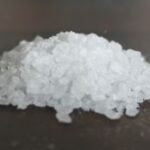How dangerous is bleach?
Chlorine bleach, as used in household cleaning, is mainly composed of sodium hypochlorite. This is the kind you can buy in liquid or gel form. You can also sometimes buy it as a powder. An enormous volume of bleach is flushed from our homes into the drainage system everyday.
How bad is this for the environment?
This does not sound like such a great thing but the truth is that most chlorine bleaches do break down harmlessly into salts and water. Dangerous compounds such as dioxins can be produced in an acid environment – but this does not usually occur in domestic locations. The environmental authorities regard the effects of chlorine bleach upon water systems as negligible. The industrial use of chlorine bleach is an entirely different matter, which is why you should think carefully before buying bleached nappies and other products. Oxygen bleaches are chemically different and they are safer for the environment.
The manufacturing of chlorine bleach
Chlorine bleach can be a significant hazard in the workplace. Workers in chemical plants which make it can be badly affected by exposure to fumes.
Health hazards of bleach in the home
Bleach is an irritant. The fumes are unpleasant and can pose a health hazard. Undiluted, bleach is corrosive and will damage many surfaces such as skin and fabrics.
Children and bleach
There are accidental poisonings of children from time to time. In the UK homes more than three hundred young children suffer accidents involving bleach each year. The figures for adults are worse – according to RoSPA as many as 700 people each year have accidents involving bleach. Many people with respiratory complaints find bleach fumes can be intolerable.
Wood decking and other products
You should definitely avoid using bleach if you bought decking or other outdoor wood products more than a few years back. Your purchase might contain CCA, a dangerous chemical which becomes more dangerous when combined with bleach. Most of these products were taken off the market by 2003 in the US but lots of people still have them in their gardens.
If you think you may have such products, then don’t use bleach or deck brighteners on them. If toddlers or young children are to play on such decking always lay down a thick mat over the wood.
Using bleach safely
Avoid using bleach in confined spaces such as cupboards where the fumes may be concentrated. If you really must use bleach in such places, wear a good face mask and dilute the product well. Air your rooms well after bleach has been used to dispel the fumes. Don’t let bleach come in contact with your skin, especially undiluted bleach.
Bleach is not great for clothes except in very diluted form as it may cause damage to the fabric.
Never, never use bleach mixed with other products as an experiment!
The risk of really hazardous fumes is too great. Use bleach in dilution with water according to the manufacturers instructions. People who have asthma or other breathing difficulties should be particularly careful about using bleach. Also be very careful of bleach splashes. If any should get into your eye, splash it with water for about 15 minutes and get medical help. Get some fresh air after using bleach and if you have any concerns about its effects upon your health consult your physician.
How safe is vinegar and bleach?
Is this potent combination a useful mix for household use?
Vinegar lowers the acidity of bleach, making it a more potent killer of bactericia. This is too dangerous for domestic use. When an acid is mixed with bleach, chlorine gas is given off. It is toxic and can be a real health risk. Vinegar is a powerful bactericide by itself. If you still feel you need to use bleach (and there are quite a few alternatives) use it unmixed with other cleaners. Bleach can be used diluted in water to top up your cleaning programme. Vinegar and bleach is best left to professionals.
Why use bleach at all?
Bleach is an effective cleaner because it works well on stains. Also, everything looks so sparkling and clean afterwards. Vinegar, washing soda and baking soda, good as they are – don’t have quite the same powerful effect upon stains and ground in dirt. But if you use all the excellent natural cleaners now available you can probably manage without using bleach for most of the time. Diluted vinegar, for example, is good for cleaning sinks and surfaces and borax and baking soda can do a lot. If you want that unstained look, try an oxygen bleach. You need to soak things for longer than you would with chlorine bleach but it has a similar effect. Oxygen bleaches are generally sold for use on fabrics but they work quite well on other materials – such as worktops and plastic dish-washing bowls.


